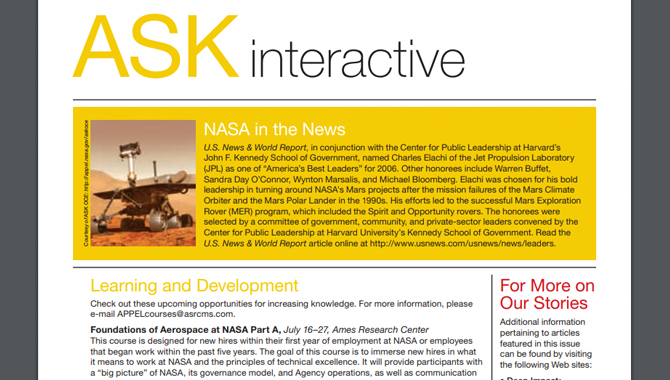Here are two true stories about organizational effectiveness. We leave it to you to think about their relevance to NASA and knowledge.
Three Heads Are Better Than One
When Megan was 14, she began to have trouble swallowing and could not seem to keep food down. Her parents brought her to the family general practitioner. He examined her and ordered some tests. Finding nothing obviously wrong, he assured Megan and her parents that the problem would take care of itself.
But Megan’s digestive problem got worse and she began to lose weight. She went to one specialist who prescribed an antibiotic that had no effect on her condition. Other doctors who examined Megan were baffled. She continued to have trouble eating and continued to lose weight.
Her parents took her to the Hospital for Sick Children in Toronto. Soon after she was admitted, three specialists entered Megan’s room together: an internist, an allergist, and a gastroenterologist. They had all studied her records. They asked a few questions and examined her. Then, in the room with Megan and her parents, they shared their ideas.
The allergist said he was fairly sure the problem was not a food allergy.
“Yes, I think it’s an infection,” the gastroenterologist said.
The internist agreed and thought he knew why the earlier course of antibiotic treatment had not worked.
Megan had been ill for weeks. Now, within five minutes, the three physicians agreed on a diagnosis and a treatment— a particular antibiotic effective against the somewhat unusual infection she had contracted. Her rapid recovery proved them right.
Decision Making at W. L. Gore
The W. L. Gore companies have built their business on one chemical compound—polytetrafluoroethylene—and on a particular idea of management. They have turned the polymer into electrical insulation, artificial veins, Gore-tex, and Glide dental floss. Gore prides itself on the independence and creativity of its employees. At Gore, anyone can make any decision relevant to his or her work that is not “below the waterline”—that is, that would not sink a division or the company if it proved to be a bad one.
Research scientist Robert Henn’s experience shows the decision-making philosophy in action. Some years ago, Henn began to think about a $500,000 piece of testing equipment that he believed could aid his research. He discussed the idea with his colleagues. He was enthusiastic about the equipment, but half a million dollars was a lot of money.
One day, CEO Bill Gore came into his office and said, “I hear you’re thinking about spending $500,000 on a new piece of equipment.”
Henn admitted that he was.
“Tell me, Bob,” Gore went on, “if this device does everything you imagine it can do, will it give us results that can help us improve our products or develop new ones?”
Henn had obviously thought about that question and found it easy to answer: yes, he believed the device would have practical and profitable applications.
“If it fails,” Gore asked, “if it turns out to be a $500,000 paperweight, will your division survive?”
Henn hadn’t asked himself exactly that question. Gore waited while he mulled it over. Eventually he said, “If it turns out to be useless, that would be personally embarrassing to me, but, yes, the division would survive.”
“Then why haven’t you ordered it?” Gore asked. So he did.








